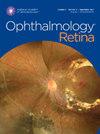PDE6A-Associated Retinitis Pigmentosa, Clinical Characteristics, Genetics, and Natural History
IF 4.4
Q1 OPHTHALMOLOGY
引用次数: 0
Abstract
Purpose
To analyze the genetics, clinical characteristics, and natural history of PDE6A-associated retinitis pigmentosa.
Design
Retrospective, longitudinal, observational cohort study.
Participants
Patients with molecularly confirmed PDE6A-associated retinal dystrophy in a single tertiary referral center.
Methods
Review of medical records and retinal imaging, including fundus autofluorescence (FAF) imaging and spectral-domain OCT. Genetic results were reviewed, and the detected variants were assessed.
Main Outcome Measures
Molecular genetic testing, clinical findings including best-corrected visual acuity (BCVA), qualitative and quantitative retinal imaging analysis.
Results
Sixteen patients (32 eyes) were identified and evaluated longitudinally. Genetic analysis identified 14 variants in the PDE6A gene, including 8 novel variants. The mean age (± standard deviation, range) was 34.8 years (± 17.4, 12–76) at baseline, with a mean follow-up time of 4.8 years. Best-corrected visual acuity was 0.45 ± 0.45 logarithm of the minimum angle of resolution (logMAR) (range 0.0–1.6) at baseline and 0.65 ± 0.7 logMAR (range 0.0–2.3) at the last visit. Best-corrected visual acuity was similar among eyes in 88% of patients. A hyperautofluorescent ring was observed on FAF in 50% and 43.8% of the eyes at baseline and follow-up visit, respectively, with a mean area of 9.7 ± 4.5 mm2 at baseline and mean of 8.6 ± 4.8 mm2 at the follow-up visit. Mean horizontal ellipsoid zone width (EZW) at baseline was 1765 ± 1093 μm, which decreased to 1580 ± 1077 μm at follow-up. Eighteen eyes exhibited cystoid macular edema at baseline (56%), and 17 eyes (53%) at follow-up. There were statistically significant changes during the follow-up period in terms of BCVA, hyperautofluorescent ring area, and the EZW.
Conclusions
This study highlights the natural history of PDE6A-retinopathy. Most patients in this cohort had mild BCVA loss, and slowly progressive disease, based on FAF and OCT measurements.
Financial Disclosure(s)
Proprietary or commercial disclosure may be found in the Footnotes and Disclosures at the end of this article.
与 PDE6A 相关的视网膜色素变性、临床特征、遗传学和自然史。
目的:分析与 PDE6A 相关的视网膜色素变性的遗传学、临床特征和自然病史:回顾性、纵向、观察性队列研究:方法:回顾病历和视网膜成像:回顾病历和视网膜成像,包括眼底自动荧光(FAF)成像和光谱域光学相干断层扫描(SD-OCT)。审查基因结果,评估检测到的变异:结果:对 16 名患者(32 只眼睛)进行了鉴定和纵向评估。遗传分析确定了 PDE6A 基因中的 14 个变异,包括 8 个新型变异。基线平均年龄(±SD,范围)为 34.8 岁(±17.4,12 - 76),平均随访时间为 4.8 年。基线最佳矫正视力(BCVA)为 0.45 ± 0.45 LogMAR(范围 0.0 - 1.6),最后一次就诊时为 0.65 ± 0.7 LogMAR(范围 0.0 - 2.3)。88%的患者双眼BCVA相似。在基线和随访时,分别有 50%和 44% 的眼睛在 FAF 上观察到高荧光环,基线时的平均面积为 9.7 ± 4.5 mm2,随访时的平均面积为 8.6 ± 4.8 mm2。基线时的平均水平椭圆带宽度(EZW)为 1765 ± 1093 μm,随访时降至 1580 ± 1077 μm。基线时有 18 只眼睛(56%)出现囊样黄斑水肿,随访时有 17 只眼睛(53%)出现囊样黄斑水肿。随访期间,BCVA、高自发光环面积和EZW均发生了统计学意义上的显著变化:本研究强调了PDE6A视网膜病变的自然史。根据FAF和OCT测量结果,该队列中的大多数患者BCVA轻度减退,病情缓慢进展。
本文章由计算机程序翻译,如有差异,请以英文原文为准。
求助全文
约1分钟内获得全文
求助全文

 求助内容:
求助内容: 应助结果提醒方式:
应助结果提醒方式:


